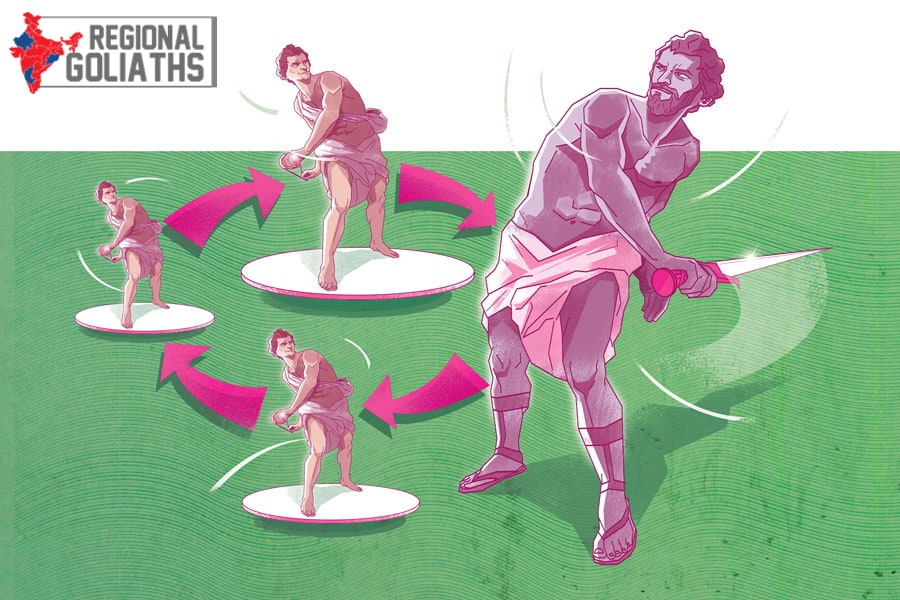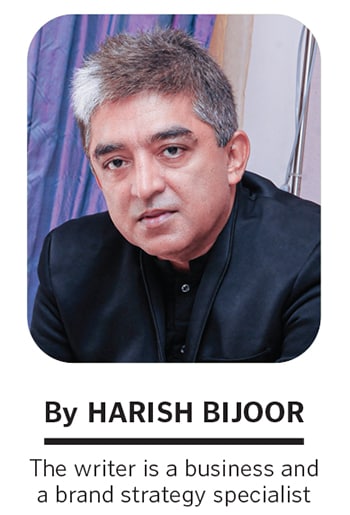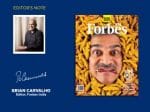Do Davids want to become Goliaths?
Every Goliath today was once a David, a wannabe Goliath. And every David aspires to become a Goliath. But what if a David falls in love with being a David?
 Illustration: Chaitanya Dinesh Surpur
Illustration: Chaitanya Dinesh Surpur
I n the beginning, every brand is small. In fact, every brand starts as a thought—call it dry seeds—that gets the right kind of backing and effort. What makes it big? A good product, a great price, well-oiled distribution, a savvy brand, and, most important, an excellent set of people.
n the beginning, every brand is small. In fact, every brand starts as a thought—call it dry seeds—that gets the right kind of backing and effort. What makes it big? A good product, a great price, well-oiled distribution, a savvy brand, and, most important, an excellent set of people.
When I look at regional brands, every effort has been an effort of involved passion. Behind every big brand, there is a passionate entrepreneur. At times, even more than one founder. The Haldiram’s bhujiya from Nagpur that I love, the kadak Gujarati Tulsi Tea I wash it down with, the Bhima Jewels at Kochi where I buy my wedding gold, and the Walkaroo sandals from Coimbatore that I buy for grip and comfort during the monsoons… all started small.
In many ways, each of them was once a David, and, later on, each is either a Goliath (like Haldiram’s), or well on the way to be one. Every Goliath today was once a David, a wannabe Goliath. And every David aspires to become a Goliath.
Let’s start with Davids.
‘David brands’ happen in the remotest corners of the country. These are brands that study the local market in the gullies of India and create micro-successes out of them. These brands occupy the prime position of salience and volume dominance in niche pockets. Bindu Cola, for one, is a big brand in Karnataka. In Dakshina Kannada district, this tangy Cola is a big hit, giving Coca-Cola and Pepsi a run for their money.‘ David brands’ know how to fight the big. They occupy a high ground, dominate the local taste, fight against the status-quo taste, and create a space in the palate wars. They master distribution finesse and out-fight the Goliath-brand on price. Their promotions are localised and are custom-fitted to the retailer and consumer alike.
‘David brands’ work harder, as they are always a No.2 if not on a lower rung in the stake for market share and volumes alike. In many ways, ‘David brands’ love their status. Being second biggest makes them sweat it out more and not take their finger off the pulse of their customer and the distribution chain. And, in many ways, ‘David brands’ do not know how to be ‘Goliath brands’. For all you know, they don’t even want to be that. David is in love with David. ‘Davidism’ is a religion of the David-brand entrepreneur. It’s a passion a founder sticks to even after the ‘David brand’ is sold.
Yes, while a few Davids succeed, some give up on the way and sell out to the Goliath. At times, this sell-out is to an existing brand, venture capitalist or private equity. Result? David gets gobbled up by a Goliath. What happens to the promoter of the David brand then? Do they vanish into the shadows with loads of money? Do they take off to the Bahamas and live a different life altogether?
Well, the answer is a big no. The entrepreneur never gives up.
Take the story of MTR from Bengaluru. A 100-year-old brand today, MTR started as Mavalli Tiffin Rooms in 1924. The first OG restaurant near Lalbagh in Bengaluru was, and is, a set of rooms in an old Bungalow style… a small restaurant put together by Parampalli Yagnanarayana Maiya. Going to MTR was a moment I looked forward to as a kid in shorts. You never got a table and you just had to wait in queues. And when you got your table, it was pure bliss. The rava idli, invented right out here in MTR, with its small miniature little “gindla” (katori) of ghee, was and is a big hit to this day.
Also read: When regional supremacy trumps national ambitions
Reputation grew and so did the brand. In 1975, the owners decided to start their range of packaged food items… chutney powders, chutneys, masalas, and more. The instant foods range fell into place, ready-to-eat and ready-to-cook foods came by, and the ice cream range was a hit. The business was then split between two sides of the family. While one son, Sadananda Maiya, took charge of the packaged foods business, the other side expanded the chain of specialty Karnataka Brahmin food restaurants globally.
With growth came a professional CEO, and the David from Mavalli was getting ready to be a Goliath. Years passed, and a Norwegian giant of an enterprise picked up MTR into its fold. The Orkla Group became the Goliath owner, and the rest is history.
So what happened to the entrepreneurs who sold MTR? Do they buy an island paradise and retire? No. Sadananda Maiya decides to bide over the cooling period and launch his range of packaged foods. He starts with a restaurant called Maiyas. Now, Maiyas is the new MTR. He then launches a range of foods, masalas, ready-to-eat and ready-to-cook foods for India and the diaspora. While MTR is the Goliath now, Maiyas is the David. Once again, this David wants to be a Goliath one day. An entrepreneur who sells out wants to be an entrepreneur. That is the ‘karma’ of the David-entrepreneur. That is his dharma even.
Look around. The story repeats across a host of entrepreneurs who built ‘David brands’, and then sold them to the Goliaths. Anchor sold to Panasonic. The entrepreneurs who put together Anchor are today the David brand evangelists of Great White. Ditto for Havmor. The promoter family of the ice cream brand started Hocco. The Adigas chain of restaurants and Paakashala are prime examples from a host of many.
The David-entrepreneur is, therefore, a David-entrepreneur, and it becomes a way of life, and a habit. You build one enterprise for decades, and when you sell it, you miss it dearly. And so, you recreate it. A David-brandmaker is always a David-brandmaker. That is his life. Create. Nurture. Grow. Fight. Sell. Repeat.
I sometimes wonder whether David enjoys being a Goliath ever. While the brand is inanimate and can’t give me an answer, the brand promoters can talk and tell. My hunch: Being David is a mindset. It’s a philosophy. A David is always happy being a David. Goliath is a goal. When that goal is achieved, little is left to do. A David needs a Goliath, just as a Goliath always needs many Davids to keep him on his toes. Dancing. Touché.
(This story appears in the 09 August, 2024 issue of Forbes India. To visit our Archives, click here.)

















